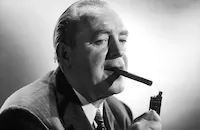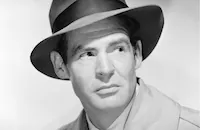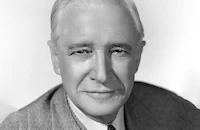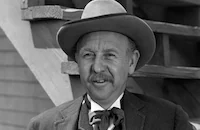The Boy with Green Hair

Brief Synopsis
Cast & Crew
Joseph Losey
Pat O'brien
Robert Ryan
Barbara Hale
Dean Stockwell
Richard Lyon
Film Details
Technical Specs

Synopsis
In a police station, a sad, bald-headed boy, who has refused to reveal his name or utter a word, is questioned by Dr. Evans, an expert on "boys." Coaxed by Dr. Evans, the boy, Peter Frye, finally relates his story: After his parents are killed while doing relief work in war-torn Europe, Peter is shipped from relative to relative, until he is taken in by family friend Gramp Frye, an Irish-born widower living in a small town. Although at first wary of his new home, Peter soon comes to trust and respect the understanding Gramp, a former vaudevillian and magician who works nights as a singing waiter. Peter is unaware that his parents are dead, and Gramp, afraid to upset the boy, allows him to believe that they will someday return for him. At his new school, Peter makes friends quickly and later gets a job delivering groceries and joins in a clothing drive for war victims. Peter's newfound happiness ends abruptly, however, when a classmate unwittingly tells him that he is an orphan and compares him to a pathetic-looking boy in a war orphan poster on display at the school. Peter pretends to shrug off the painful news, but is filled with confused feelings about his parents' death. That night, he questions Gramp about death and war, and during their discussion, Gramp mentions that his wife loved to grow green plants, which she felt symbolized the hope of spring. Gramp then promises Peter he will have a surprise waiting for him in the morning. The next day, after Peter takes his bath, he discovers that his hair has turned green and assumes that Gramp is behind the "trick." Gramp, however, tells Peter that his surprise was a magician's scarf and takes Peter to see Dr. Knudson. When the baffled doctor suggests that Peter either dye his hair or cut it off, the boy refuses to consider either option and asks Gramp if he can stay at home until his hair returns to its former color. Eventually, a bored and lonely Peter dares to venture outside and, as he and Gramp walk to school, draws the stares of curious passersby. Although Gramp challenges the hysterical attitudes of his neighbors, some of whom believe Peter's green hair is the result of tainted milk, Peter remains the target of speculation and is ridiculed and ostracized by his schoolmates. Even after Miss Brand, Peter's kindhearted teacher, tries to ease the other children's fears by pointing out that only one child in the class has red hair, Peter feels rejected. That night, Peter tears in two a letter that his father had left for him to read on his sixteenth birthday and runs away to some nearby woods. There, after Peter gives in to his pent-up tears, he hears a young voice calling his name. To his amazement, Peter discovers all of the children from the war orphan posters standing, alive, in the woods. When Michael, the frail poster boy to whom Peter was once compared, suggests that his green hair is the "mark of something good," Peter bristles with sarcasm. Michael soon changes Peter's feelings, however, and advises him to use his unusual hair to call attention to the horrors of war. Following the boy's instructions, the now-inspired Peter goes from adult to adult, explaining to them that his hair is green because he is a war orphan. Peter's words fail to soothe the town's fears, and he is told that he is ruining the milkman's business because the people are convinced that his hair is the result of contaminated milk. When Peter is asked by various adults to cut off his hair, he once again refuses, stating that it has "meaning." He then returns to the woods, hoping to find the poster children there, but instead is chased by his male classmates, who are determined to cut off his hair. Peter escapes from the woods, but when he returns home, Gramp, who wants his foster son to be happy and carefree, suggests that shaving his hair might be the only remedy to his problems. Reluctantly Peter agrees to have his hair cut, but cries silent tears as the barber shaves his head in front of Gramp and a crowd of onlookers. Peter's brave tears cause Gramp and the crowd to grow suddenly ashamed of themselves. Although Gramp later apologizes to Peter for not supporting him, Peter runs away from home. Back in the police station, Dr. Evans gently chides Peter for not having more faith in himself and then returns him to Gramp, who is waiting outside with Dr. Knudson and Miss Brand. Feeling that Peter is now mature enough, Gramp reads from his father's torn letter. Written shortly before his father's death, the letter reassures Peter of his parents' love and asks him to remind people who might otherwise forget about the terrible price of war. Moved by the letter, Peter declares that he hopes his hair will grow back green and returns home with his proud foster father.

Director

Joseph Losey
Cast

Pat O'brien

Robert Ryan

Barbara Hale

Dean Stockwell

Richard Lyon

Walter Catlett

Samuel S. Hinds

Regis Toomey
Charles Meredith
David Clarke
Billy Sheffield
John Calkins
Teddy Infuhr
Dwayne Hickman
Eilene Janssen
Curtis Jackson

Charles Arnt
Don Pietro
Patricia Byrnes
Carol Coombs
Cynthia Robichaux
Georgette Crooks
Donna Jo Gribble
Billy White

Rusty Tamblyn
Baron White
Speer Martin
Michael Losey
Al Murphy
Anna Q. Nilsson
Lynn Whitney
Eula Guy
Brick Sullivan
Kenneth Patterson

Dayle Robertson
Carl Saxe
Sharon Mcmanus

Ann Carter
Howard Brody
Ray Burkett
Warren Shannon
Diana Graeff
Roger Perry
Wendy Oser

Charles Lane
Max Rose
Crew
Eden Ahbez
Stephen Ames
C. Bakaleinikoff
Adele Balkan
George Barnes
Ben Barzman
Gordon Bau
Ralph Berger
Albert S. D'agostino
Frank Doyle
Gil Grau
Leigh Harline
Natalie Kalmus
Richard Kinon
James Lane
Alfred Lewis Levitt
Morgan Padelford
Clem Portman
Edwin Pyle
Hazel Rogers
Ruby Rosenberg
Dore Schary
Darrell Silvera
William Stevens
Rod Tolmie
Ralph Wildman
Earl Wolcott

Videos
Movie Clip


Hosted Intro
Film Details
Technical Specs

Articles
The Boy With Green Hair - The Boy With Green Hair
Impressed by Losey's work in the New York stage, which included a 1947 production of Bertolt Brecht's Galileo Galilei starring Charles Laughton, Schary entrusted Losey with the direction of The Boy With Green Hair even though the director's only previous film experience had been in such shorts as A Gun in His Hands (1945), an Oscar-nominated entry in MGM's "Crime Does Not Pay" series.
The Boy With Green Hair is a gentle anti-war fable in which a war orphan (Dean Stockwell) awakens one day to find that his hair has turned green. This makes him an object of ridicule in his small town, where the locals call for the boy's head to be shaved. After running away, the child dreams of other war orphans who urge him to return to the town and make its citizens aware of how simple differences can escalate into armed conflict. Unfortunately, the film's themes remain all too timely today.
Unfortunately for Losey, the eccentric, politically conservative Howard Hughes took over RKO while The Boy With Green Hair was being made and, hating the film's pacifist message, did his best to sabotage it. Losey, however, managed to protect the integrity of his project. Screenwriter Ben Barzman would later recall that "Joe shot the picture in such a way that there wasn't much possibility for change. A few lines were stuck in here and there to soften the message, but that was about it."
Barzman also remembered that 12-year-old Stockwell was called into Hughes' office and told that when the other children spoke of the horror of war, he should say, "And that's why America has gotta have the biggest army, and the biggest navy, and biggest air force in the world!" According to Barzman, little Stockwell was in so in sympathy with the film's message that he dared to respond, "No, sir!" Even after Hughes started to scream at him, the boy held his ground.
Although Stockwell would recall much of his career as a child actor in negative terms, he genuinely liked and admired Losey -- even after the director was deliberately "cruel" to get the boy to cry on cue. Losey said later that he had "adored" Stockwell and regretted having to reduce him to tears by talking about the death of a pet kitten. "It's interesting that Joe felt he was being cruel," Stockwell later said. "It shows the warmth, the sensitivity of the man."
Blacklisted in Hollywood after being summoned by the House Un-American Activities Committee in 1951, Losey moved to Great Britain, where he created some of his most highly praised films including The Damned (1963) and Pinter's The Go-Between (1971). Relocating to France in 1976, Losey remained active in films until his death in 1984.
Producers: Stephen Ames, Dore Schary (Executive producer)
Director: Joseph Losey
Screenplay: Ben Barzman and Alfred Lewis Levitt from story by Betsy Beaton
Cinematography: George Barnes
Art Direction: Ralph Berger, Albert S. D'Agostino
Costume Design: Adele Balkan
Original Music: Leigh Harline
Editing: Frank Doyle
Cast: Pat O'Brien (Gramp), Robert Ryan (Dr. Evans), Barbara Hale (Miss Brand), Dean Stockwell (Peter Frye), Richard Lyon (Michael), Walter Catlett (The King), Samuel S. Hinds (Dr. Knudson), Regis Toomey (Mr. Davis).
C-83m.
by Roger Fristoe

The Boy With Green Hair - The Boy With Green Hair
Quotes
Trivia
Notes
In the opening credits, Dean Stockwell's character name is listed as "The Boy." eden ahbez' name is spelled entirely in lower case letters onscreen; according to modern sources, the composer preferred this spelling for religious reasons. "Nature Boy" was the only song he is known to have written. In addition to the indicated flashbacks, the film also used voice-over narration delivered by Stockwell. In mid-November 1947, Adrian Scott, who had just produced RKO's successful social film Crossfire , was announced as this picture's producer. By late November 1947, however, Scott and his frequent collaborator Edward Dmytryk were fired by RKO for violating the morality clause of their contract because they had refused to "name names" during hearings of the House Committee on Un-American Activities (HUAC). Scott and Dmytryk became the first two members of the "Hollywood Ten," a group of filmmakers charged with contempt of Congress and subsequently blacklisted by the movie industry because of reputed connections to the Communist Party. In 1951, Scott was sentenced to a year of imprisonment after Dmytryk finally identified him as a Communist. Director Joseph Losey was also blacklisted in 1951, and this film is frequently cited as contributing to his image as a Communist subversive. For more information on the HUAC hearings, see entry for Crossfire.
Los Angeles Times reported in its This Week section that after RKO bought Betsy Beaton's story, it shelved the project for almost a year because of story problems. In a modern interview, Losey, who made his feature-directing debut with this film, recalled that he and Scott worked on the script with the screenwriters. Losey added that the original story was a fantasy about racial discrimination, but that its thrust was changed because he and his collaborators felt that a film about peace would be more timely and important. RKO production head Dore Schary said in a January 1948 New York Times article that, contrary to declarations by "the leftists" and pressures from the right, the story was to be made as a "pro-peace picture" with "no change in subject-matter." According to Hollywood Reporter, after Scott's departure from the project, the script was completely revamped for producer Stephen Ames. Hollywood Reporter notes that The Boy with Green Hair was made as part of RKO's "experiment" with modestly budgeted quality pictures, the first of which was the highly successful Crossfire. In the modern interview, Losey stated that when Scott was still involved in the project, he wanted to shoot it in 16mm color stock to save money. Because Ames was a major stockholder in Technicolor, Losey added, he could obtain 35mm color stock cheaply, thereby making it possible to produce the picture in Technicolor on a relatively modest budget. (Contemporary sources give the film's budget as between $850,000 and $900,000.) Losey also claimed that Ames's status at Technicolor helped to overcome some of the company's artistic restrictions, such as not using dark browns or low-key lighting while shooting.
RKO borrowed Stockwell from M-G-M for this production. Albert Sharpe, who played "Finian" in the Broadway production of Finian's Rainbow, was to make his screen debut in the picture, according to Hollywood Reporter. Losey recalled in the modern interview that the part of Gramp was written with Sharpe in mind, but that RKO insisted that O'Brien, who was a contract star, be cast. Rusty Tamblyn and Dale Robertson made their screen debuts in the production. The CBCS lists Robertson's first name with its original spelling, "Dayle." In the CBCS, Peter Brocco is credited in the role of "Mr. Hammond #1," but it unclear whether he actually appeared in the film, as Charles Arnt is also listed as "Mr. Hammond." Losey stated that he used two cameras to shoot the hair cutting scene and had Stockwell wear three different wigs during the sequence. According to Los Angeles Times, Stockwell wore wigs throughout the picture because the studio feared that he would be ridiculed in his private life if his hair were dyed green. New York Times notes that to save money, primary sets from I Remember Mama (see below) were used.
According to the Variety review, Howard Hughes, who acquired RKO in the spring of 1948, demanded that this film be re-edited to remove the "tolerance theme," which he felt detracted from the entertainment value of the picture. A Daily Variety news item claims that Floyd Odlum, who was the chairman of RKO's board, actually ordered the re-editing and insisted that the only acceptable "message" was one for "preparedness." According to a August 3, 1948 Daily Variety article, new footage was to be shot to stress the fantasy elements of the picture. On August 30, 1948, Daily Variety announced that after RKO executive vice-president Ned Depinet and two members of the RKO board viewed the revised picture, Depinet decided to restore the original cut. The disputed footage, which cost $150,000 to produce, included new background music as well as new scenes. Losey added in the modern interview that "a few extra lines off screen were stuck in in an attempt to soften the message." Despite Schary's desire to release the film in mid-1948, Hughes delayed the release for six months, according to Losey. (Protesting Hughes's interference with this and other films, Schary left RKO in July 1948.) Daily Variety also notes that "Nature Boy," which is sung by an offscreen group, cost RKO $10,000 and was almost cut from the picture. As used, "Nature Boy," which was popularized by Nat King Cole in 1947, is an early example of a credit sequence theme song. The Irish folk song "Tail o' Me Coat" is performed by Pat O'Brien and Walter Catlett as part of a brief fantasy sequence.

Miscellaneous Notes
Released in United States Winter December 27, 1948
Released in United States January 1998
John Hubley was not credited as the production designer consultant.
Released in United States Winter December 27, 1948
Released in United States January 1998 (Shown in New York City (Walter Reade) as part of program "7th Annual New York Jewish Film Festival" January 10-22, 1998.)















